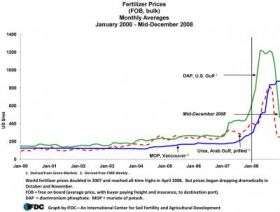World fertilizer prices drop dramatically after soaring to all-time highs

World fertilizer prices began dropping dramatically in late 2008 after reaching all-time highs around April.
The price of urea, the world's most common nitrogen fertilizer, rose from about $280 to $405 per ton in 2007 and reached $452 in April 2008. The price then soared to $815 per ton in August—but plunged to $247, lower than before the price spiral began, in mid-December.
The price of diammonium phosphate (DAP) increased by five times—from $262 to $1,218 per ton—from January 2007 to April 2008, but had fallen to $469 per ton in mid-December.
Potash is the only fertilizer whose price is still rising. Standard grade muriate of potash, the most common source of potassium, sold for $172 per ton in January 2007 and $875 per ton in mid-December.
Why Fertilizer Prices Spiked: A "Perfect Storm"
"Numerous factors converged simultaneously to cause fertilizer prices to soar, then suddenly collapse. Some have compared the series of events to 'a perfect storm.'"
Prices were essentially driven up by an imbalance between supply and rapidly expanding demand, especially in Asia, Gregory explains. Fertilizer demand reached a level that supply could not match. Demand was particularly strong in China and India. Another factor was increased demand for fertilizers to produce biofuels in the United States, Brazil, and Europe. Increased livestock production created still more demand for grain and thus for fertilizers. Grain reserves became historically low and prices rose sharply.
Further worsening the situation were China's imposition of high tariffs on fertilizer exports and the devaluation of the U.S. dollar in 2007 and 2008. Energy prices peaked, causing an increase in the price of natural gas—essential for nitrogen fertilizer production. Phosphate prices were also driven up by a huge increase in demand and prices for sulfur, vital for production of the popular DAP and other high-analysis phosphate fertilizers. The supply of quality phosphate rock also became tight.
Why Prices Then Plunged Rapidly
"But potash prices have stayed high due to its shortage and difficulties in transporting Russian potash because of an enormous and expanding sinkhole near the Silvinit mines," Gregory says. "Demand for potash increased from 2006 through 2008, and potash inventories are now 37% lower than over the past 5 years."
Price movements will probably be volatile for at least the next 2 years, until new production facilities open and the current lower prices for nitrogen and phosphate recover, Gregory says.
Source: IFDC





















